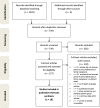The preferences and perspectives of family caregivers towards place of care for their relatives at the end-of-life. A systematic review and thematic synthesis of the qualitative evidence
- PMID: 25991565
- PMCID: PMC5256384
- DOI: 10.1136/bmjspcare-2014-000794
The preferences and perspectives of family caregivers towards place of care for their relatives at the end-of-life. A systematic review and thematic synthesis of the qualitative evidence
Abstract
Background: Home is often reported as the preferred place of care for patients at the end-of-life. The support of family caregivers is crucial if this is to be realised. However, little is known about their preferences; a greater understanding would identify how best to support families at the end-of-life, ensuring more patients are cared for in their preferred location.
Objectives: To systematically search and synthesise the qualitative literature exploring the preferences and perspectives of family caregivers towards place of care for their relatives at the end-of-life.
Methods: Ten databases (MEDLINE, PsycINFO, EMBASE, AMED, ASSIA, CINAHL, Social Care Online, Cochrane Database, Scopus, Web of Science) and reference lists of key journals were searched up to January 2014. Included studies were appraised for quality and data thematically synthesised.
Results: Eighteen studies were included; all were of moderate or high quality. Two main themes were identified: (1) Preferences and perspectives: most family caregivers preferred home care, although a range of perspectives were reported. Both positive and negative perspectives of home, hospices and hospitals emerged. At times, family caregivers reported feeling obligated to provide home care. (2) Impact of facilitating home care; both positive and negative effects on family caregivers were reported.
Conclusions: Many family caregivers reported home as the preferred place of care; other places of care were infrequently considered. Healthcare professionals and service providers should be aware of these preferences and provide support where needed to enable family caregivers to successfully care at home, thus improving end-of-life experiences for families as a whole.
Keywords: End-of-life preferences; Family caregiving; Home care; Palliative care; Systematic review.
Published by the BMJ Publishing Group Limited. For permission to use (where not already granted under a licence) please go to http://www.bmj.com/company/products-services/rights-and-licensing/.
Conflict of interest statement
None.
Figures
References
-
- Marie Curie Cancer Care. Committed to carers: supporting carers of people at the end of life, 2012.
-
- Payne S. EAPC Task force on family carers. White Paper on improving support for family carers in palliative care: part 1. Eur J Palliat Care 2010;17:238–45.
-
- Department of Health. End of Life Care Strategy: promoting high quality care for adults at the end of their life. Department of Health, 2008.
Publication types
MeSH terms
Grants and funding
LinkOut - more resources
Full Text Sources
Other Literature Sources
Medical


